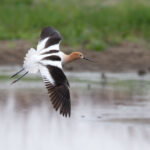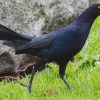By Kathleen McCoy
Almost everywhere you look outside lots of black birds of different sizes and shapes are seen. The biggest one of all in the Phoenix metro area is the Great-tailed Grackle, whose shiny iridescent black glows purple in the right light. The male is almost 18 inches long. Very long legs, a yellow eye and a massive tail rounds out its description. The females with dark eyes are a little smaller at 16” and feathered with a golden-brown head and chest over a soft chestnut brown body. Except for the similar shape you might think the males and females are different species.
These conspicuous songbirds are long tailed grackles from the family Icteridae. They almost name themselves with all their squawking, peeping and cackling. Long tailed grackles are very noisy and social often seen in flocks ranging from a few pairs to hundreds. By night they roost in trees, at times with thousands of their best friends. In the day, they are strutting and hopping confidently on land, but they may venture into shallow water to add a frog or fish to their meal. They often are seen in small groups, searching for any kind of food. Look for them hunting for cracked corn and milo under your bird feeder. In the city these boisterous birds will eat anything palatable, even food from garbage cans.
Food is the magnet that has brought long-tailed grackles to Arizona. Originally native to north and south America, the clever bird headed its beak toward developing food sources. As humans began creating more agricultural settings and created cities, habitats were modified to fit the lifestyle of the ever-resilient migrant. The omnivorous grackles eat a lot of bugs in the summer and seeds in the cooler months. The good news is they control the insect population, including those harmful to plants. Seed eating can be problematic on farmlands when dining on crops.
Sighted first in 1935 in Arizona, their population has spread north from Mexico. Initially only summer visitors to Arizona, long-tailed grackle numbers have grown, and now some have taken permanent residence in many parts of the state. Some think of the grackle as an invasive species, but others find this bird to be very adaptable, a sign of intelligence. In fact, the grackle is a very bright bird. They are good problem solvers and have been seen using basic tools like sticks to dig for insects or and collaborating in social interactions.
Grackles are omnivorous. They mainly eat bugs in the summer, seeds in the winter — plus the occasional baby mouse, rat, lizard or assorted critter when the opportunity presents itself. But they control insect populations, and a lot of those insects are harmful to plants,” she says. “And they fit into the food chain well — they eat things and things eat them.”
Grackles serve as prey food for other valuable creatures, including foxes and hawks. And their behavior is interesting to watch.
Photo/Macauley Library
First published in Desert Rivers Audubon Magazine









